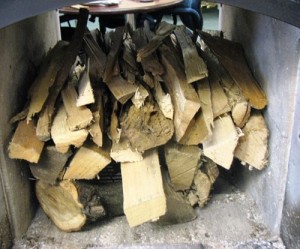Starting A Fire: The top down method
1) To start a fire you need three things, A) oxygen, B) heat and , C) fuel. The initial heat will come from your match, the fuel is your wood and the oxygen is supplied by the draft of the appliance.

Fire needs all three of these ingredients to burn effectively.come from your match, the fuel is your wood and the oxygen is supplied by the draft of
2) Open the damper (If applicable) and air shutter on your appliance.
3) Begin with preheating the flue. This can usually be done with a rolled up lit newspaper or a hair dryer. Once preheated you should notice a change in the air flow. (This can also be done with a draw collar. For more information please visit www.drawcollar.com or see a sales person for a demonstration.)
4) Begin building your fire.
5) Start by placing small pieces of fuel wood on the bottom of your fireplace or stove. If possible place the wood front to back. Placing the wood front to back will help the air mix in the appliance.
6) Place an ample amount of dry kindling on top of the fuel wood.
7) Next place several pieces of tinder on top of the kindling to ignite your fire. There should be enough tinder on top to light with a single match.
8) When finished your wood should be at least halfway up the opening of the door.
9) As the fire burns from the top to bottom it will continue to ignite the wood below. This should result in a “light it and forget it procedure” and will also limit the amount of smoke that is produced from the fire.
10) After a good hot fire has been established you can close your bypass damper and continue to use your appliance as normal.
11) After 30-40 minutes your blower should come on.
*The National Fire Protection Association Standard 211 says, “Chimneys, fireplaces, and vents shall be inspected at least once a year for soundness, freedom from deposits, and correct clearances. Cleaning, maintenance, and repairs shall be done if necessary.”

